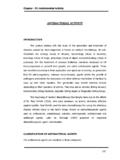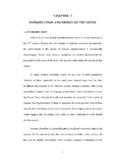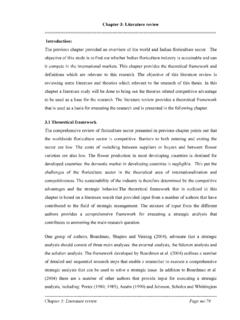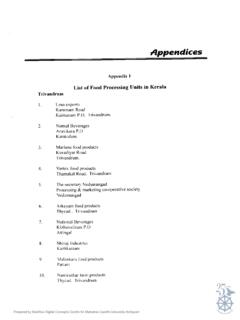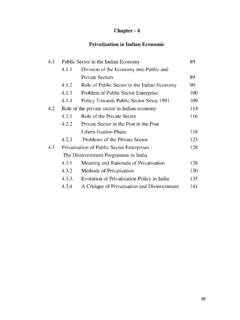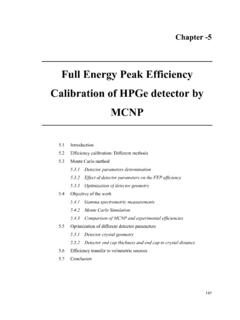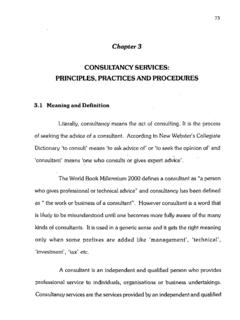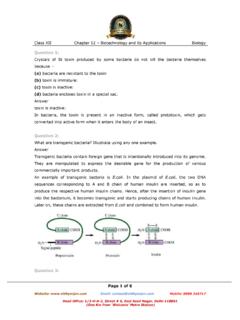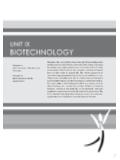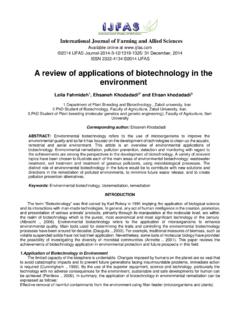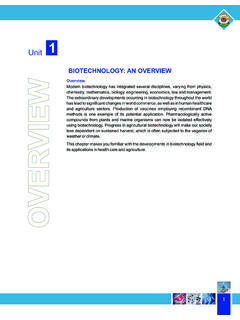Transcription of CONCLUSION AND SUGGESTIONS - Shodhganga
1 CONCLUSION AND SUGGESTIONS biotechnology as the term suggests is futuristic in all respects. Anyone who is trying to explore what is happening in the area of biotechnology research will be astonished to see the magnificent developments that are taking place. Gone are the days of technology of cross breeding, brewing bear and making bread using yeast; biotechnology today is a science where you can program your cell to meet your biological requirement. The genomic research once amazed every one with revelation of genetic mark up and genetic codes. The tiny little cells and the complexity of genetic regulation inside them are great wonders of nature. But it represents a daunting challenge to unravel the mysteries of this complex structure. As the biotechnology research kept unravelling these mysteries, it burdened upon the traditional legal system to safe guard the Intellectual Property Rights (IPRs) associated with it.
2 The biotechnology research involved huge amount of intellectual and financial investment. The protection of biotechnology research and innovations became a major challenge to the researchers and legal experts. biotechnology research has some peculiarities when compared to other areas of science. The nature of genomic research is a kind of gene exploration which normally forms only discoveries which are basically against the traditional patent philosophy. Another issue is that the biotechnology research is the unveiling of an already existing product of the nature which again is unpatentable. An in(depth analysis of these issues is made in the preceding chapters. The thesis is divided into four analytical sections. The first section gives an introduction to biotechnology and explains various concepts and technology jargons related to the area of research.)
3 The second section narrates various intellectual property issues related to biotechnology research. This particular section spread over chapters two and three covers issues related to patenting of biotechnology innovation, which include patent philosophies, the current trends, major shortcomings and finally Judicial and legislative attempts to harmonise the various issues. The section also covers the protection of biotechnology and evaluates the contemporary problems related to biotechnology research data in the copyright landscape. The third section introduces the open source concept in the software sector, its philosophy, 334development methodology, classification, advantages and its legal foundations. The fourth and final part explores open source analogy as a new intellectual property management strategy in biotechnology sphere.
4 It evaluates various open source initiatives, open collaborative endeavours and the concept of patent pooling based on open source concepts in order to see whether open source management strategy is effective in fostering innovations. The study, streamlined according to the chapterisation based on the above scheme attempts to establish the entire hypothesis to be true. It is well understood that the traditional patent system failed to abridge the three potential areas of proprietary concerns, social interest and scientific growth. It is also proved that the basic research data relating to gene sequences and isolated proteins fall outside the ambit of traditional patent regime. Another possible alternative mechanism to protect the research data was copyright, which is again confronted with many shortcomings. The study successfully establishes that the open source licensing concept, similar to that in the software sector, can alleviate many problems faced by biotechnology .
5 Thus, the study establishes that the intellectual property licensing based on open source concept, is an effective research data management strategy to foster innovation by maintaining a perfect balance between proprietary concerns and social interest. Summary of Chapters The theme of this research is centered around the contemporary area of biotechnology research and the allied intellectual property rights. A basic understanding of biotechnology as a subject is very essential to understand the intellectual property issues relating to it, and it makes this area slightly interdisciplinary. The first chapter gives a detailed introduction to biotechnology , its basic concepts, historical aspects, classification, technology application, areas of application and so on. The purpose of the chapter is well served, as it briefly and clearly narrates almost all the relevant areas required for the continued understanding of the issues of intellectual property rights.
6 The chapter explains the basic terminology of biotechnology , its definition and the major activities relating to it. It makes a detailed historical analysis of the development of the modern biotechnology research and a maximum effort is made to 335bring in almost all the relevant intellectual property events in the biotechnology development path. Further the chapter makes a detailed reference to the cell structure, what a Deoxyribonucleic Acid (DNA) is and what it encodes. The chapter explains the relationship between DNA, Ribonucleic Acid RNA and the proteins in order to give a basic understanding about the cell function. Further the chapter illustrates some of the basic technology applications like bio(processing technologies, cell or tissue culture, recombinant DNA technologies, cloning and so on. Chapter one also gives a detailed illustration of the types of biotechnology applications like medical biotechnology , agricultural application and so on.)
7 It also explains the most contemporary areas like bioinformatics, nano( biotechnology , genetically modified organisms, Single Nucleotide Polymorphisms (SNPs) and Expressed Sequence Tags (ESTs). These are the most significant areas in biotechnology research which pose many contemporary intellectual property issues in biotechnology research. This section of the chapter is particularly relevant in this study because the subsequent chapters of the study are largely related to the intellectual property issues pertaining to these main areas. Chapter two deals with many paradoxical issues related to patent protection in biotechnology research. It gives a brief historical analysis of the patent system followed by a detailed explanation of patent philosophies and theories. The evaluation of the various theories shows that they are envisioned to protect either proprietary interest or the interest of the society.)
8 Most of the reciprocal arrangements envisaged by these theories are made only with an objective of securing their respective views. This situation can be better illustrated with an example. The natural right theory claims patent as a natural right for time and money the inventor has expended in bringing out the new product. Hence patent is an incentive to invent. Whereas the incentive to disclose theory argues that the exclusive protection granted to the inventor is for disclosing the invention to the public. The moral and philosophical rationale of the patent system has been justified by various patent theories. Another significant area which the chapter explains is the various motivations behind the inventive activity. Motivations for innovators involved in inventive activities are generally classified as intrinsic and extrinsic.
9 Self driven 336individuals, with out commercial objectives, can be considered intrinsically motivated. Whereas, the extrinsic motivations are those which are driven by economic incentives. The evaluation of these concepts proves that intrinsic motivations are more powerful than extrinsic ones and they contribute to fostering of innovation. The second chapter exhaustively deals with the major issues posed by the traditional patent regime when applied to the area of biotechnology research. One view held by the economists is that the patent system will cause rent dissipation. The concept of rent in economics means, returns over and above the costs required to produce the goods or to keep them in production. The Intellectual property rights can sometimes give rise to socially wasteful duplicative or uncoordinated inventive activities resulting in wastage of socially desirable resources.
10 In simple language, the concept of rent dissipation in economics, suggests that IPRs may cause socially wasteful resources. Further, this chapter also evaluates various research and empirical studies conducted by different scholars and it is shown that the patents are the most expensive IPRs to maintain. They involve huge transaction costs and the patent litigations are the most expensive among all IPRs The study reveals that too many patents relating to a particular area have caused patent proliferation resulting in patent thickets and research bottlenecks. Further, the patent proliferation has resulted in widespread anticommons effect in biotechnology research. The term anticommons describes a situation where several individuals own patent rights to exclude others. By using their exclusive rights, they are in a position to restrict other s access to use the common resources.
